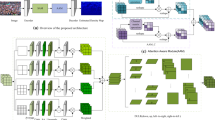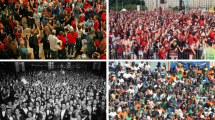Abstract
With the emergence of deep learning, many CNN-based methods have achieved competitive performance in crowd counting, in which how to effectively solve the scale variation problem plays a key role. To tackle with the problem, we present an innovative scale self-guided crowd counting network (SS-CCN) by taking full advantage of scale information in a multi-level network. The proposed SS-CCN highlights crowd information by applying scale enhancement and scale-aware attention modules in multi-level features. Moreover, semantic attention module is applied on deep layers to extract semantic information. Besides, the fine-grained residual module is proposed to further refine the crowd information. Furthermore, we pioneer a scale pyramid loss with different loss functions applied to different scales. Integrating the proposed module, our method can effectively solve the scale variation problem. Extensive experimental results on several public datasets show that our proposed SS-CCN achieves satisfactory and superior performance compared to the state-of-the-art methods.
Access this chapter
Tax calculation will be finalised at checkout
Purchases are for personal use only
Similar content being viewed by others
References
Sindagi, V.A., Patel, V.M.: Ha-ccn: hierarchical attention-based crowd countingnetwork. IEEE Trans. Image Process 29, 323–335 (2019)
Sindagi, V.A., Patel, V.M.: Generating high-quality crowd density maps usingcontextual pyramid cnns. In: Proceedings of the IEEE International Conference Oncomputer Vision, pp. 1861–1870 (2017)
Dollar, P., Wojek, C., Schiele, B., Perona, P.: Pedestrian detection: an evaluation ofthe state of the art. IEEE Trans. Pattern Anal. Mach. Intell. 34(4), 743–761 (2011)
Idrees, H., Saleemi, I., Seibert, C., Shah, M.: Multi-source multi-scale counting inextremely dense crowd images. In: Proceedings of the IEEE Conference on Computervision and Pattern Recognition, pp. 2547–2554 (2013)
Jiang, X., et al.: Attention scaling for crowd counting. In: Proceedings of the IEEE/CVF Conferenceon Computer Vision and Pattern Recognition, pp. 4706–4715 (2020)
Zhang, Y., Zhou, D., Chen, S., Gao, S., Ma, Y.: Single-image crowd counting viamulti-column convolutional neural network. In: Proceedings of the IEEE Conferenceon Computer Vision and Pattern Recognition, pp. 589–597 (2016)
Sam, D.B., Surya, S., Babu, R.V.: Switching convolutional neural network forcrowd counting. In: 2017 IEEE Conference on Computer Vision and Pattern Recog-nition (CVPR), pp. 4031–4039. IEEE (2017)
Guo, D., Li, K., Zha, Z.J., Wang, M.: Dadnet: dilated-attention-deformable con-vnet for crowd counting. In: Proceedings of the 27th ACM International Conferenceon Multimedia, pp. 1823–1832 (2019)
Liu, L., Qiu, Z., Li, G., Liu, S., Ouyang, W., Lin, L.: Crowd counting with deepstructured scale integration network. In: Proceedings of the IEEE/CVF Interna-tional Conference on Computer Vision, pp. 1774–1783 (2019)
Liu, X., Yang, J., Ding, W., Wang, T., Wang, Z., Xiong, J.: Adaptive mixtureregression network with local counting map for crowd counting. In: ComputerVision - ECCV 2020–16th European Conference, pp. 241–257 (2020)
Hu, Y., Jiang, X., Liu, X., Zhang, B., Han, J., Cao, X., Doermann, D.S.: Nas-count:counting-by-density with neural architecture search. In: Computer Vision - ECCV2020 - 16th European Conference, pp. 747–766. Glasgow, UK 2020, Proceedings, Part XXII (2020)
Rong, L., Li, C.: Coarse-and fine-grained attention network with background-awareloss for crowd density map estimation. In: Proceedings of the IEEE/CVF WinterConference on Applications of Computer Vision, pp. 3675–3684 (2021)
Gao, J., Wang, Q., Yuan, Y.: Scar: Spatial-/channel-wise attention regression net-works for crowd counting. Neurocomputing 363, 1–8 (2019)
Miao, Y., Lin, Z., Ding, G., Han, J.: Shallow feature based dense attention net-work for crowd counting. In: Proceedings of the AAAI Conference on ArtificialIntelligence. vol. 34, pp. 11765–11772 (2020)
Simonyan, K., Zisserman, A.: Very deep convolutional networks for large-scaleimage recognition. In: 3rd International Conference on Learning Representations, ICLR 2015, San Diego, USA, 2015, Conference Track Proceedings (2015)
Idrees, H., et al: Composition loss for counting, density map estimation and localization in densecrowds. In: Proceedings of the European Conference on Computer Vision (ECCV), pp. 532–546 (2018)
Zhang, C., Li, H., Wang, X., Yang, X.: Cross-scene crowd counting via deep con-volutional neural networks. In: Proceedings of the IEEE conference on computervision and pattern recognition, pp. 833–841 (2015)
Li, Y., Zhang, X., Chen, D.: Csrnet: dilated convolutional neural networks forunderstanding the highly congested scenes. In: Proceedings of the IEEE conferenceon computer vision and pattern recognition, pp. 1091–1100 (2018)
Jiang, X., Xiao, Z., Zhang, B., Zhen, X., Cao, X., Doermann, D., Shao, L.: Crowdcounting and density estimation by trellis encoder-decoder networks. In: Proceed-ings of the IEEE/CVF Conference on Computer Vision and Pattern Recognition, pp. 6133–6142 (2019)
Ma, Z., Wei, X., Hong, X., Gong, Y.: Bayesian loss for crowd count estimation withpoint supervision. In: Proceedings of the IEEE/CVF International Conference onComputer Vision, pp. 6142–6151 (2019)
Wang, Q., Gao, J., Lin, W., Yuan, Y.: Learning from synthetic data for crowdcounting in the wild. In: Proceedings of the IEEE/CVF Conference on ComputerVision and Pattern Recognition, pp. 8198–8207 (2019)
Boominathan, L., Kruthiventi, S.S., Babu, R.V.: Crowdnet: a deep convolutionalnetwork for dense crowd counting. In: Proceedings of the 24th ACM internationalconference on Multimedia, pp. 640–644 (2016)
Acknowledgement
This work is supported by the National Natural ScienceFoundation of China (61976127).
Author information
Authors and Affiliations
Corresponding author
Editor information
Editors and Affiliations
Rights and permissions
Copyright information
© 2021 Springer Nature Switzerland AG
About this paper
Cite this paper
Zheng, J., Xie, J., Lyu, C., Lyu, L. (2021). SS-CCN: Scale Self-guided Crowd Counting Network. In: Mantoro, T., Lee, M., Ayu, M.A., Wong, K.W., Hidayanto, A.N. (eds) Neural Information Processing. ICONIP 2021. Lecture Notes in Computer Science(), vol 13111. Springer, Cham. https://doi.org/10.1007/978-3-030-92273-3_25
Download citation
DOI: https://doi.org/10.1007/978-3-030-92273-3_25
Published:
Publisher Name: Springer, Cham
Print ISBN: 978-3-030-92272-6
Online ISBN: 978-3-030-92273-3
eBook Packages: Computer ScienceComputer Science (R0)




